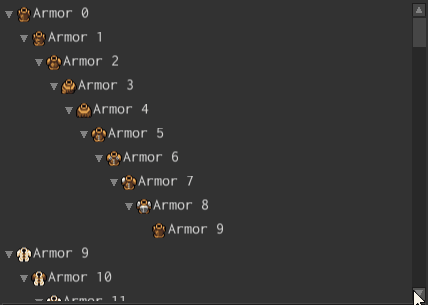Tree

Tree widget allows you to create views for hierarchical data. It could be used to show file system entries, graphs, and anything else that could be represented as a tree.
Examples
A simple tree with one root and two children items could be created like so:
#![allow(unused)] fn main() { use fyrox_ui::{ core::pool::Handle, text::TextBuilder, tree::{TreeBuilder, TreeRootBuilder}, widget::WidgetBuilder, BuildContext, UiNode, }; fn create_tree(ctx: &mut BuildContext) -> Handle<UiNode> { // Note, that `TreeRoot` widget is mandatory here. Otherwise some functionality of // descendant trees won't work. TreeRootBuilder::new(WidgetBuilder::new()) .with_items(vec![TreeBuilder::new(WidgetBuilder::new()) .with_content( TextBuilder::new(WidgetBuilder::new()) .with_text("Root Item 0") .build(ctx), ) .with_items(vec![ TreeBuilder::new(WidgetBuilder::new()) .with_content( TextBuilder::new(WidgetBuilder::new()) .with_text("Child Item 0") .build(ctx), ) .build(ctx), TreeBuilder::new(WidgetBuilder::new()) .with_content( TextBuilder::new(WidgetBuilder::new()) .with_text("Child Item 1") .build(ctx), ) .build(ctx), ]) .build(ctx)]) .build(ctx) } }
Note, that TreeRoot widget is mandatory here. Otherwise, some functionality of descendant trees
won't work (primarily - selection). See TreeRoot docs for more detailed explanation.
Built-in controls
Tree widget is a rich control element, which has its own set of controls:
Any Mouse Button - select.
Ctrl+Click - enables multi-selection.
Alt+Click - prevents selection allowing you to use drag'n'drop.
Shift+Click - selects a span of items.
ArrowUp - navigate up from the topmost selection.
ArrowDown - navigate down from the lowermost selection.
ArrowRight - expand the selected item (first from the selection) or (if it is expanded), go
down the tree.
ArrowLeft - collapse the selected item or (if it is collapsed), go up the tree.
Adding Items
An item could be added to a tree using TreeMessage::AddItem message like so:
#![allow(unused)] fn main() { use fyrox_ui::{ core::pool::Handle, message::MessageDirection, text::TextBuilder, tree::{TreeBuilder, TreeMessage}, widget::WidgetBuilder, UiNode, UserInterface, }; fn add_item(tree: Handle<UiNode>, ui: &mut UserInterface) { let ctx = &mut ui.build_ctx(); let item = TreeBuilder::new(WidgetBuilder::new()) .with_content( TextBuilder::new(WidgetBuilder::new()) .with_text("Some New Item") .build(ctx), ) .build(ctx); ui.send_message(TreeMessage::add_item( tree, MessageDirection::ToWidget, item, )); } }
Removing Items
An item could be removed from a tree using TreeMessage::RemoveItem message like so:
#![allow(unused)] fn main() { use fyrox_ui::{ core::pool::Handle, message::MessageDirection, tree::TreeMessage, UiNode, UserInterface, }; fn remove_item(tree: Handle<UiNode>, item_to_remove: Handle<UiNode>, ui: &UserInterface) { // Note that the `ui` is borrowed as immutable here, which means that the item will **not** // be removed immediately, but on the next update call. ui.send_message(TreeMessage::remove_item( tree, MessageDirection::ToWidget, item_to_remove, )); } }
Setting New Items
Tree's items could be changed all at once using the TreeMessage::SetItems message like so:
#![allow(unused)] fn main() { use fyrox_ui::{ core::pool::Handle, message::MessageDirection, text::TextBuilder, tree::{TreeBuilder, TreeMessage}, widget::WidgetBuilder, UiNode, UserInterface, }; fn set_items(tree: Handle<UiNode>, ui: &mut UserInterface) { let ctx = &mut ui.build_ctx(); let items = vec![ TreeBuilder::new(WidgetBuilder::new()) .with_content( TextBuilder::new(WidgetBuilder::new()) .with_text("Item 0") .build(ctx), ) .build(ctx), TreeBuilder::new(WidgetBuilder::new()) .with_content( TextBuilder::new(WidgetBuilder::new()) .with_text("Item 1") .build(ctx), ) .build(ctx), ]; // A flag, that tells that the UI system must destroy previous items first. let remove_previous = true; ui.send_message(TreeMessage::set_items( tree, MessageDirection::ToWidget, items, remove_previous, )); } }
Expanding Items
It is possible to expand/collapse trees at runtime using TreeMessage::Expand message. It provides
different expansion strategies, see docs for TreeExpansionStrategy for more info. Tree expansion
could useful to highlight something visually.
#![allow(unused)] fn main() { use fyrox_ui::{ core::pool::Handle, message::MessageDirection, tree::{TreeExpansionStrategy, TreeMessage}, UiNode, UserInterface, }; fn expand_tree(tree: Handle<UiNode>, ui: &UserInterface) { ui.send_message(TreeMessage::expand( tree, MessageDirection::ToWidget, true, TreeExpansionStrategy::RecursiveAncestors, )); } }